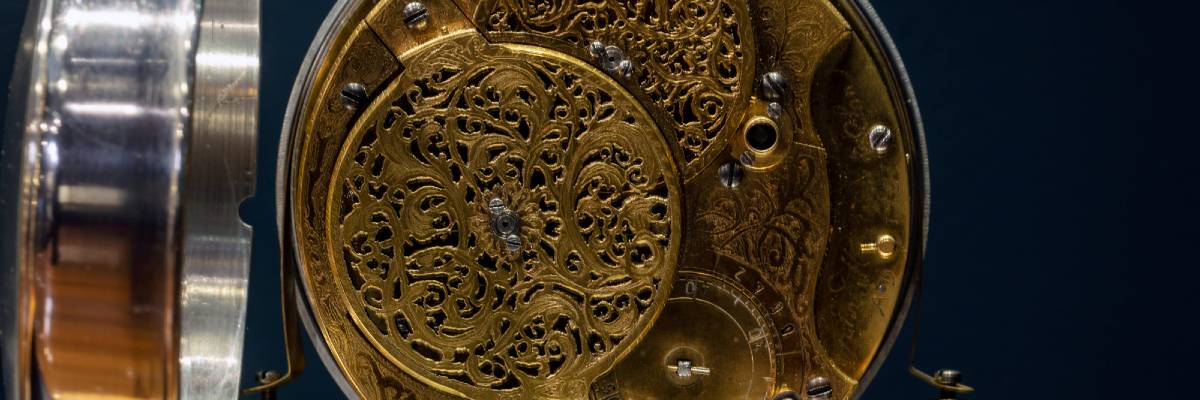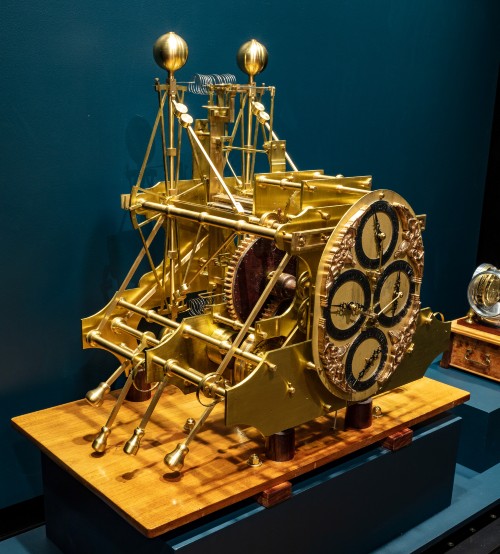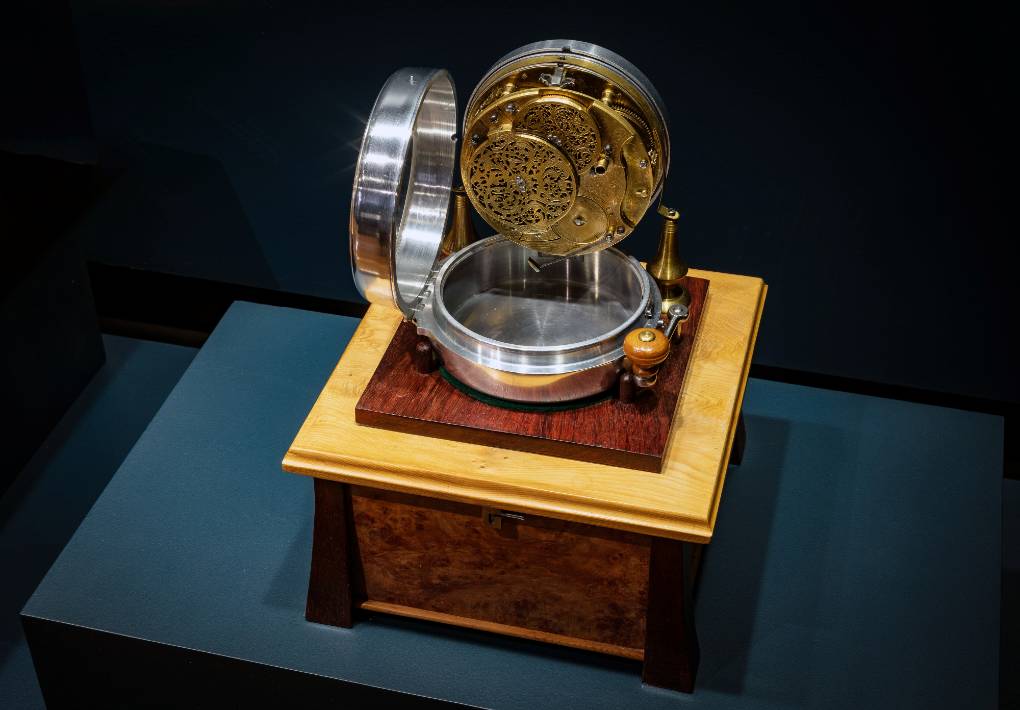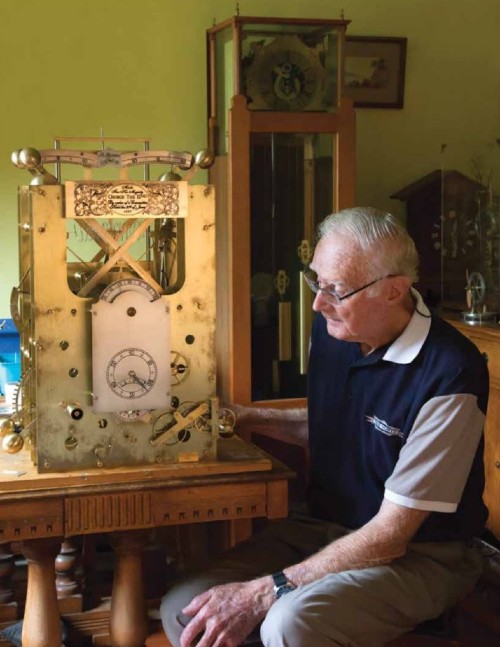
A visit to the museum in 2004 changed Norman Banham’s life and will one day reward the nation with a set of intricate mechanical masterpieces in brass and timber – his replicas of John Harrison’s famed marine chronometers of the 18th century, which solved the vexing problem of longitude.
In 2004, retired scientific instrument maker Norman Banham visited the museum to view the exhibition About Time. The amateur clock enthusiast was transfixed by a feature object in that exhibition – a magnificent marine chronometer known as H1, developed by Englishman John Harrison in the 18th century in his epic quest to solve the longstanding problem of longitude, or determining the east–west position of ships at sea relative to the north–south meridians of latitude.
Back then, the intricate replica made by Leonard Salzer in 1970 and held in the collections of Royal Museums Greenwich was on a special visit to Sydney.1 The majesty of Harrison’s clock enthralled Mr Banham and sparked in him an odyssey to make these clocks anew:
I remember being mesmerised. The clock fascinated me and I watched it working for a long time. In the clock, art, knowledge and science combined to create something that changed the world
In a remarkable feat of problem-solving, Mr Banham channelled John Harrison’s energy and tenacity over a 20-year period to fashion four working replicas of his series of clocks known as H1, H2, H3 and H4. The sea watch H4, the fourth of Harrison’s five chronometers, eventually won him rewards and recognition from the Board of Longitude.
Famously, the problem of longitude had transfixed empires for hundreds of years. Ship masters were easily able to determine latitude by sighting the sun at its highest point. Longitude, however, relied on comparative measurements from arbitrary lines, and calculations between the time on board a ship at sea and the time at a home port, or another place of known longitude.

Replica of John Harrison’s marine chronometer H1, made and lent by Norman Banham, on display in the museum’s exhibition Under Southern Skies
Keeping accurate time at sea had proved elusive given the actions of the rolling seas and fluctuations in temperature, moisture and weather over long distances across latitudes. Thousands of people drowned when ships foundered on unexpected landforms or died from diseases such as scurvy after ship masters spent excessive time finding their way to port. Valuable cargoes, too, were lost.
Between the 16th and 18th centuries, the maritime nations of Spain, the Netherlands, France and Britain offered financial rewards to solve the problem while their best and brightest philosophised over potential solutions. A much-publicised, drawn-out ideological battle developed between esteemed astronomers and mathematicians who looked to the stars for a solution in observations of planets and the Earth’s moon, and those who looked to mechanical timekeeping, or a sea clock.
The chief protagonist of mechanical timekeeping was the legendary former carpenter John Harrison, who began his quest in the 1720s, after the British Longitude Act was announced in 1714. It consumed 50 years in a mammoth battle against two successive Astronomers Royal, James Bradley and Nevil Maskelyne. Harrison’s supporters petitioned King George III and Harrison was eventually vindicated and awarded £10,000 in 1765 and a further £8,750 in 1773, after his fourth design was proved ‘practicable’, or able to be produced by others.2

Norman Banham’s replica of Harrison’s sea watch H4. With completely different workings to Harrison’s previous chronometers, H4 featured a large balance wheel which beat more rapidly to combat the motion of the seas
Each of Harrison’s four clocks was an improvement on the previous as he resolved problems of the day. H1, his first clock of 1735, took him more than a decade to develop. This design was endorsed by the Royal Society and met the conditions of the Longitude Act at sea trials, but Harrison himself suggested improvements and continued work with seeding funding from the Longitude commissioners. This led to more than 20 years of refinement then a further two decades of debate with the Board of Longitude.
Harrison’s developmental models became smaller, although still heavy and box like, until 1759, when he unveiled a timepiece redesigned into an eminently more practical housing based on an enlarged pocket watch, made by clockmaker John Jefferys. To prove its practicality, it was produced by chronometer maker Larcum Kendall and successfully trialled by James Cook on his second voyage in 1772–75, being tested against chronometers made by John Arnold and the lunar distance method. Harrison’s fifth watch, H5, involved a new design to correct the time by moving the hands without opening the back of the clock.
Two hundred and fifty years later, the ingenious machinery in Harrison’s clocks captivated Norman Banham, who set himself the challenge to make the clocks anew with a replica set of chronometers that demonstrated Harrison’s experimentations.
Whereas in the 16th to 18th centuries astronomy and mechanics were at odds, in 21st-century Canberra they were fused in the skills and life story of Norman Banham. Mr Banham, who recently turned 90, spent his working career and much of his early family life at the Mount Stromlo Observatory where his father Horace, a qualified scientific instrument maker, ran the workshop. Mr Banham remembers as a young boy watching his father silvering the mirrors of one of the telescopes with silver nitrate every 12 months to maintain its reflective qualities. When he turned 16 in 1947, he left school to begin his apprenticeship in the workshop.
Mr Banham became leading hand 29 years later. His work involved machining components and instruments from drawings from the design office and fitting, adjusting and rebalancing them on and around the large telescopes. Over the course of his 40-year career, the instruments and the work became more sophisticated with the introduction of new electronic technologies.
Mr Banham retired in 1988 and became involved in the Horological Society, where his interests and expertise coalesced. He became hooked on the aesthetics and motion of the Harrison clocks – their intricacy, ingenuity and the interconnectedness of components.
Mr Banham’s biggest challenge was locating accurate plans. This took him some time and involved assistance from visiting astronomers after approaches to Greenwich proved fruitless. Eventually he was introduced to British clockmaker Don Unwin. Unwin had made a replica of H3 for the Wimpole Museum, Cambridge, and generously helped Mr Banham procure a copy of Harrison’s plans of H3 lodged at Cambridge University.
Astoundingly, it was only after he completed H3 several years later and moved on to H4 that Mr Banham realised that he had started with the most complex clock. It was the only one for which he had any detail. Mr Banham had, and still has, no computer. In an epic feat of deduction, concentration and patience he scaled components from plans and one photograph of the clock that included a 12-inch (30 centimetre) ruler, and set to work with incredible finesse and tenacity, resolving all his questions of size, scale, weight and balance calibration – making and testing each component, case by case, year by year.
Materials were less of a problem. Mr Banham was able to source brass, steel and timbers – lignum vitae and oak – locally in Canberra, even if he did have to cut up the backing board from his parents’ sideboard to procure the English oak.

Norman Banham in his home workshop, 2021. He is working on his replica of H3. Image Amanda Crnkovic
Today Mr Banham continues working on Harrison’s clocks, musing over and solving problems. He is working on the long-case clock that consumed Harrison until his death in 1776. He is also working on H2. When Mr Banham crafted the replica H2 he again turned to his ruler, pencil and paper to scale from published photographs and produced a magnificent working replica. After this, the Curator of Horology at Royal Museums Greenwich, Jonathan Betts, published the detailed plans and photographs of all Harrison clocks. It was a little late for Mr Banham because he had finished his four clocks, but he realised that he had made a minute error in the size of the gear wheel, so he patiently took the entire clock apart and replaced the gear wheel. This minute change led to many, many hours recalibrating and checking all other components.
Two of Norman Banham’s extraordinary replica clocks – H1 and the sea watch H4 – are currently on loan to the museum for display in the museum’s Under Southern Skies gallery. Mr Banham has made a most generous gesture in the bequest of his replica Harrison clocks. In years to come the replicas H1, H2, H3 and H4 will enter the National Maritime Collection as a magnificent tribute to Norman Banham and John Harrison. They will serve to link astronomy and timekeeping, the Royal Observatory at Greenwich and Mount Stromlo Observatory outside Australia’s national capital, and the achievements of a clockmaker and scientific instrument maker across the centuries.
As Norman Banham said recently:
The clocks are truly fascinating maritime objects which helped solve the longitude problem. I would love Australian audiences to see the clocks through my inquisitive eyes to understand the history behind each one [and] reflect on the design and how they worked ... It has been a real inspiration to see the finished product, given the history behind it and the achievement of Harrison.
Footnotes
1 In the 2016 exhibition Ships, clocks and stars, the original H4, plus all four replicas – each made by a different clockmaker – visited Australia from a private collection in the UK.
2 These two sums are equivalent to well over $5.5 million in today’s money.
Further reading
Dava Sobel, Longitude: The true story of a lone genius who solved the greatest scientific problem of his time (Fourth Estate, UK, 1995).
